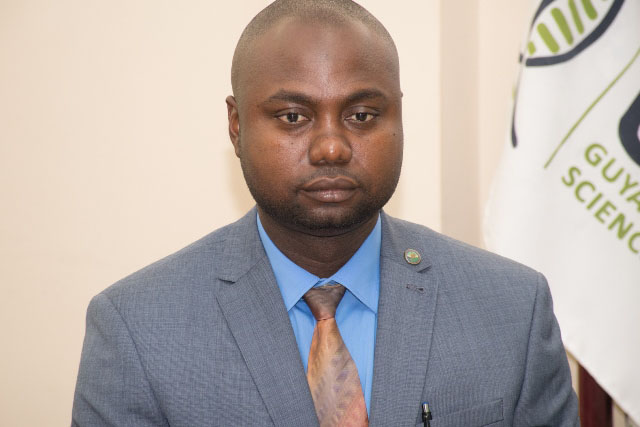With the country waiting years for this development, the Guyana Forensic Science Laboratory (GFSL) will on Friday commence DNA testing of several samples from crime scenes following the acquisition of a key piece of equipment and the training of four staff members in its use.
This is according to the entity’s Director Delon France, who said during a commissioning ceremony yesterday that once international certification is attained, the laboratory will be able to take in samples from jurisdictions outside of Guyana.
The DNA testing encompasses three main areas – comparison or matching evidence to the suspect, paternity testing and family mapping/testing where you can use the family DNA to identify a suspect even if the suspect’s DNA is unavailable.
Cheek cells, semen, vaginal secretion, hair, blood and touch DNA are among the samples that can be collected and submitted for testing.
The DNA testing equipment and a Gunshot Residue (GSR) testing device, together costing US$465,000 were sourced from an Italy-based company through funding from the Inter-American Dev-elopment Bank (IDB).
Minister of Public Security Khemraj Ramjattan said that this “good news” marks Guyana’s movement away from the rudimentary methods in scientific detection to a truly systematic scientific footing.
He said that the ceremony is a testament to government’s commitment to continually improve public safety through the adoption of modern technologies and scientific approaches.
“A key aim of our government is to provide the best tools for law enforcement so that they can be able to identify, apprehend and prosecute criminals swiftly and effectively. To do so government is making every effort to incorporate these new technologies,” he said.
He noted that the DNA equipment will also help to prove persons’ innocence and said that the GSR device, which is integral in gun crimes and can be used to test residue on glass, paint and other elements from crime scenes through comparative analysis, can help to provide investigational leads.
Stressing the usefulness of DNA testing, he said that it is expected that some cold cases such as murder, rape and unidentified human remains could be resolved.
Ramjattan spoke of how expensive it was to send samples abroad for DNA testing. “These things cost quiet a lot of money and then the time it takes to go there…the cop has to go and then go back to collect them so that there will be no interference,” he said adding that the cost per test is almost $1.5M. With the acquisition of the DNA testing equipment, the time and cost for evaluation of samples will be significant reduced.
France said that the launching for DNA testing has been a “long wait” that came with many challenges and reservations. France added that these negativities were overcome through great leadership from the Minister and in collaboration with the IDB and the Citizens Security Strengthening (CSSP) Programme team. He said that this will bring an end to having DNA testing done “under the
shadow of international experts.”
National pioneer
“With this development the laboratory is now a national pioneer for human identification using DNA testing,” he said.
“While such advancement in criminal investigation is now up on another level, it will bring adjudication to more criminal cases as time progress,” he said.
He informed that while the lab is equipped with the latest instrument used in the field of forensics, it must be stressed that “proper evidence collection is equally important to the outcome of results from analysis conducted.”
Further, he said the lab has done a number of training sessions with crime scene personnel from the police force to ensure quality samples and sampling collection. The main focus he said is on quality forensic service and the lab is currently working towards international certification with the aim of making the services more marketable thus making the facility financially viable.
He informed that there are plans to develop a national DNA data base in the future but this will require legal intervention and amendments to the existing laws especially the Police Act Chapter 16:01 Section 35 which should include DNA records to facilitate the lab’s newest achievement .
IDB’s Chief of Operations, Lorena Solorzan in her remarks said that the strengthening of criminal justice institutions is essential to safeguarding the rule of law, improving public confidence in criminal justice outcomes and facilitating national development.
“Today’s event to commemorate the acquisition of specialized equipment for the collection of physical evidence is a tangible example of the CSSP fulfilling this mandate and providing critical solutions for citizen security. Once a crime has been committed, in order for it to be solved in a timely manner, there needs to be a strong interlinkage between the investigative capacity of the police, the prosecutorial capacity of the prosecution and the deliberative capacity of the jury.”
She stressed that the use of forensic analysis helps to provide this important link by representing a strong, scientific platform that facilitates development of a common set of facts around a criminal incident and arrival at a just sentence.
Solorzan added that the range of diagnostic capabilities present in these two pieces of equipment is impressive and represents good value for money. She noted that the Rapid DNA Analysis machine can review DNA swabbed from weapons to see if they were linked to particular suspects as well as process blood, chewing gum and cigarette butts from crime scenes. These tests can also be run in less than three hours, which affords for generating investigative leads quickly once a crime is reported and improving the quality of evidence for court proceedings, she added.
“Indeed, the RDNA analysis machine is often referred to as a DNA “magic box” by enforcement authorities elsewhere,” she added.
The lab was commissioned five years ago with four departments – toxicology, documents, trace evidence and Chemistry and six non-analytical departments – security, quality system, information system, facilities operation, evidence and administration.









